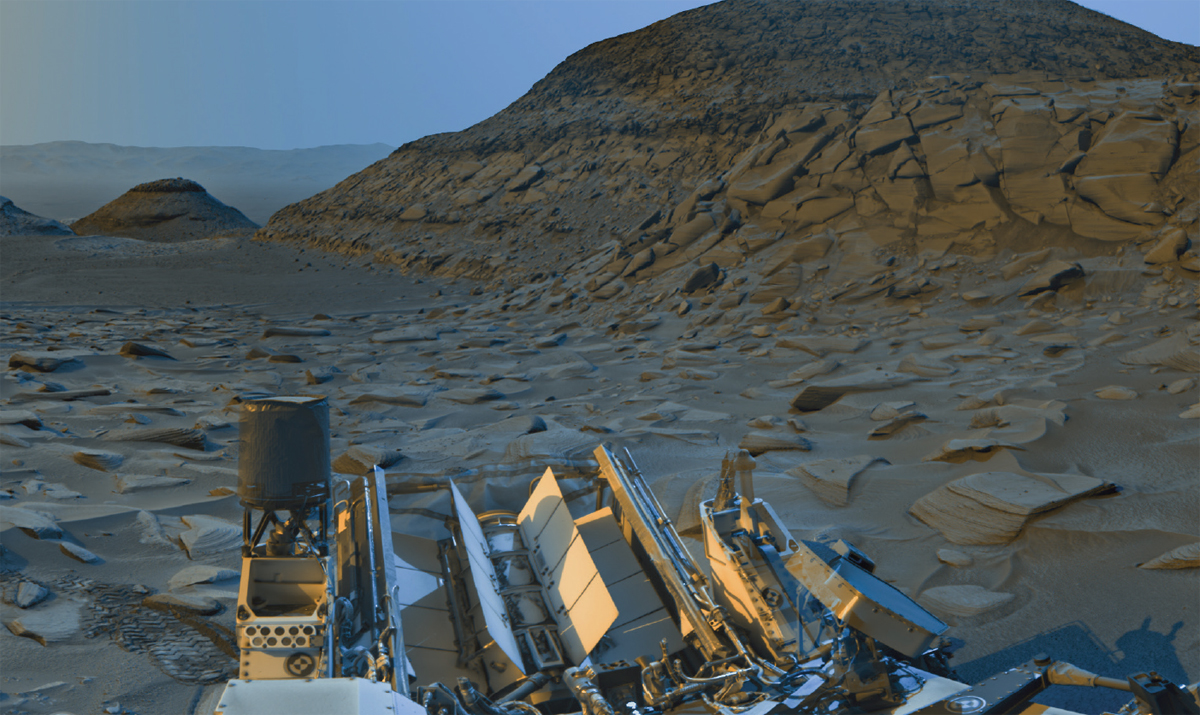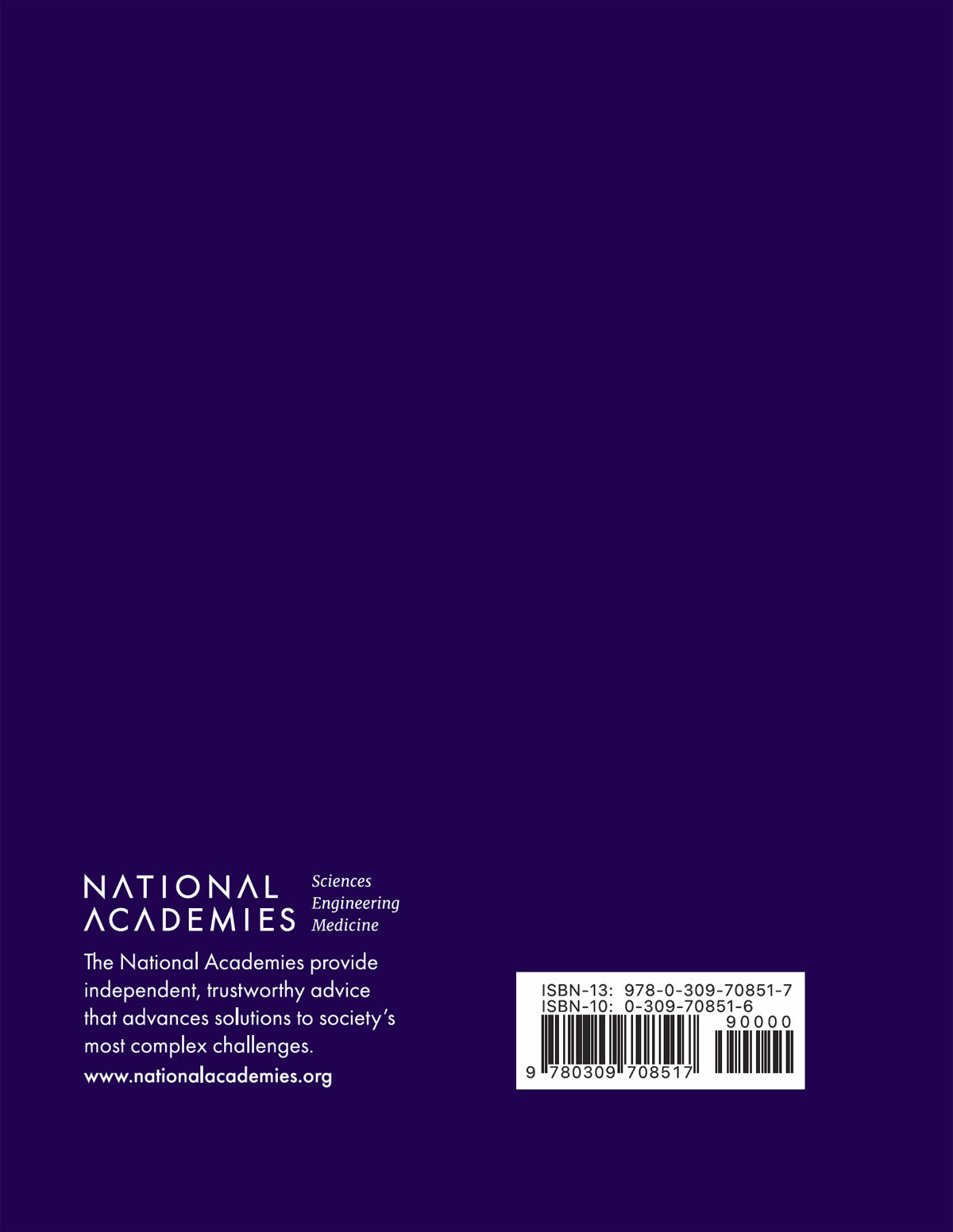
New Worlds Need New Explorers: Building Tomorrow’s Workforce
Meeting the exciting challenges in planetary science, astrobiology, and planetary defense over the coming decade will require a workforce that is highly trained, carefully selected, and effectively supported. In developing that workforce, NASA and other employers in the area will have the opportunity to move beyond some problematic practices of the past and find solutions to a number of issues affecting the profession today.
One of the major advantages for employers in the areas of planetary science, astrobiology, and planetary defense is the rich and unparalleled diversity of the people in the United States, which makes it possible to assemble teams of people with varying backgrounds, interests, capabilities, insights, and approaches to problems. But that diversity also poses challenges in hiring and keeping the field’s best and brightest.
FIGURE 49 (Above) A panoramic view down the “Marker Band Valley” as captured by the Mars rover Curiosity. By combining images taken at different times during the martian day with a degree of artistic license, optimum lighting conditions are realized across the image. The most distant feature visible in this image is some 120 km from the rover.

Many of these challenges have their roots in the unconscious attitudes and beliefs that some individuals hold concerning various groups of people. Such beliefs can lead to assumptions about an individual’s competence or intelligence or leadership abilities based on nothing more than the person belonging to a certain racial or ethnic group, sex, socioeconomic class, or other category. Research based on objective measures of behavior in the workplace has uncovered consistent evidence of such discrimination; two people can produce the same quality of work but be judged differently based on beliefs about what members of their group are capable of, not them as individuals.
Some progress has been made on this issue, particularly with the growing number of women being hired and promoted in the field. In other areas, however, such as the inclusion of members of certain racial minorities, change has been slow to come.
With its aspirational nature, NASA is an ideal place to develop initiatives aimed at addressing such issues for the overall betterment of the profession. The decadal survey recommended that such actions begin by gaining a clear and comprehensive understanding of the workforce in planetary science, astrobiology, and planetary defense, including its demographic composition and workplace climate. With that information in hand, the next step will be to determine in exactly which areas bias plays a role and then developing programs to address and eliminate the effects of the bias.
Only in this way will NASA and other institutions be able to maximize the effectiveness of their most important resource: the people who propel exploration missions and research into planetary science, astrobiology, and planetary defense.
IMAGE CREDITS AND SOURCES
Figure 1: NASA. https://www.nasa.gov/feature/update-nasa-extends-exploration-for-8-planetary-science-missions.
Figure 2: NASA/JPL-Caltech. https://www.nasa.gov/mission_pages/dawn/news/award20111130.html.
Figure 3: NASA/GSFC/ASU. http://lroc.sese.asu.edu/posts/818.
Figure 4: NASA/ESA/STScI. https://hubblesite.org/contents/news-releases/2023/news-2023-007.html.
Figure 5: NASA/Johns Hopkins University Applied Physics Laboratory/SwRI. https://www.nasa.gov/image-feature/plutos-incredible-diversity-of-surface-reflectivities-and-geological-landforms.
Figure 6: NASA/JPL-Caltech. https://europa.nasa.gov/resources/182/2021-europa-clipper-spacecraft-artists-concept.
Figure 7: NASA/JPL-Caltech. https://mars.nasa.gov/resources/26895/mars-sample-return-concept-illustration.
Figure 8: NASA, ESA, CSA, Jupiter ERS Team; image processing by Ricardo Hueso (UPV/EHU) and Judy Schmidt. https://blogs.nasa.gov/webb/2022/08/22/webbs-jupiter-images-showcase-auroras-hazes.
Figure 9: NASA/GSFC/SVS. https://roman.gsfc.nasa.gov/gallery-spacecraftillustrations.html#images-4.
Figure 10: Lisa R. Gaddis. See Gaddis and Hare. 2015. “Status of Tools and Data for Planetary Research.” Eos 96. https://eos.org/science-updates/status-tools-data-planetary-research.
Figure 11: NASA/CSIRO. https://www.cdscc.nasa.gov/Pages/gallery.html.
Figure 12: NASA/GRC. https://www1.grc.nasa.gov/space/geer.
Figure 13: NSF’s NOIRLab/CTIO/AURA/H. Stockebrand. https://noirlab.edu/public/images/iotw1949a.
Figure 14: Rubin Observatory/NSF/AURA. https://gallery.lsst.org/bp/#/folder/2334406/51622237. CC BY 4.0.
Figure 15: ESO/C. Malin (christophmalin.com). https://www.eso.org/public/images/ann13016a. CC BY 4.0.
Figure 16: NASA/Christine Floss. https://www.nasa.gov/sites/default/files/thumbnails/image/x_collect.jpg.
Figure 17: NASA/Emily M. Klein, Duke University/Courtesy of National Science Foundation. https://astrobiology.nasa.gov/news/nsf-ideas-lab-program-solicitation.
Figure 18: NASA. https://astrobiology.nasa.gov/news/iron-signatures-from-the-early-solar-system.
Figure 19: UT Office of the Vice President for Research. https://habitability.utexas.edu/exploring-the-possibility-of-life-on-other-planets. Retrieved May 8, 2023.
Figure 20: NASA. https://www.nasa.gov/feature/will-we-know-life-when-we-see-it-nasa-led-group-takes-stock-of-the-science.
Figure 21: PHL@UPR Arecibo, ESA/Hubble/NASA. https://phl.upr.edu/library/media/x-mas-planets. CC BY-NC-SA 3.0.
Figure 22: NASA/ESA/CSA; image processing by András Gáspár (University of Arizona), Alyssa Pagan (STScI). https://webbtelescope.org/contents/media/images/2023/109/01GWWHHHT27VZEQ5D1MK6EHD46.
Figure 23: NASA/Johns Hopkins University Applied Physics Laboratory/Steve Gribben. https://dragonfly.jhuapl.edu/Gallery.
Figure 24: NASA Goddard Space Flight Center. https://svs.gsfc.nasa.gov/13352.
Figures 25 and 26: NASA. 2021. Uranus Orbiter and Probe: Journey to an Ice Giant System. Planetary Mission Concept Study Report for the Planetary Science and Astrobiology Decadal Survey 2023–2032. Johns Hopkins University Applied Physics Laboratory. https://tinyurl.com/2p88fx4f.
Figure 27: NASA/ESA/CSA/STScI; image processing by Joseph DePasquale (STScI). https://webbtelescope.org/contents/media/images/2023/117/01GWQDSFM5JFT8D8D2GHCBEY23.
Figure 28: Johns Hopkins University Applied Physics Laboratory. https://civspace.jhuapl.edu/initiatives/enceladus-orbilander.
Figure 29: NASA. Enceladus Orbilander: A Flagship Mission Concept for Astrobiology. Mission Concept Study Report for the Planetary Science and Astrobiology Decadal Survey 2023–2032. Johns Hopkins University Applied Physics Laboratory. https://science.nasa.gov/science-pink/s3fs-public/atoms/files/Enceladus%20Orbilander.pdf.
Figure 30: NASA/JPL-Caltech/Southwest Research Institute. https://solarsystem.nasa.gov/resources/17646/enceladus-hydrothermal-activity.
Figure 31: NASA/GSFC. https://www.nasa.gov/centers/goddard/multimedia/returntothemoon/moon_landscape_HI.html.
Figure 32: Astrobotic. https://www.astrobotic.com/media-kit/images. https://www.nasa.gov/sites/default/files/thumbnails/image/astrobotic_peregrine_pyld_ps_10.jpg.
Figure 33: NASA/Daniel Rutter. https://www.nasa.gov/viper/rover.
Figure 34: NASA. 2021. Endurance: Lunar South Pole-Aitken Basin Traverse and Sample Return Rover. Mission Concept Study Report for the Planetary Science and Astrobiology Decadal Survey 2023–2032. Jet Propulsion Laboratory, California Institute of Technology. https://tinyurl.com/2p88fx4f.
Figure 35: NASA/JPL-Caltech/MSSS/IRAP. https://photojournal.jpl.nasa.gov/catalog/PIA25915.
Figure 36: NASA. 2021. Mars Life Explorer. Mission Concept Study Report for the Planetary Science and Astrobiology Decadal Survey 2023–2032. Pasadena, CA: Jet Propulsion Laboratory, California Institute of Technology. https://tinyurl.com/2p88fx4f.
Figure 37: NASA. https://www.nasa.gov/feature/nasa-international-partners-assess-mission-to-map-ice-on-mars-guide-science-priorities.
Figure 38: NASA. 2021. CORAL: Centaur Orbiter and Lander. Mission Concept Study Report for the Planetary Science and Astrobiology Decadal Survey 2023–2032. Johns Hopkins University Applied Physics Laboratory. https://tinyurl.com/2p88fx4f.
Figure 39: NASA. 2020. Ceres: Exploration of Ceres’ Habitability. Mission Concept Study Report for the Planetary Science and Astrobiology Decadal Survey 2023–2032. Jet Propulsion Laboratory, California Institute of Technology. https://science.nasa.gov/solar-system/documents.
Figure 40: NASA. https://www.nasa.gov/sites/default/files/thumbnails/image/caesar-concept.png.
Figure 41: NASA/JPL-Caltech. https://www.lpi.usra.edu/opag/meetings/feb2018/presentations/Lunine.pdf.
Figure 42: NASA. 2020. The Lunar Geophysical Network. Planetary Mission Concept Study for the Planetary Science and Astrobiology Decadal Survey 2023–2032. Goddard Space Flight Center. https://science.nasa.gov/solar-system/documents.
Figure 43: NASA/JPL.
Figure 44: NASA. 2021. Titan Orbiter and Probe. Mission Concept Study Report for the Planetary Science and Astrobiology Decadal Survey 2023–2032. Jet Propulsion Laboratory. https://tinyurl.com/2p88fx4f.
Figure 45: Joe Bergeron. http://www.joebergeron.com/satclouds2.htm.
Figure 46: NASA. 2021. Triton Ocean World Surveyor: A Neptune Orbiter and Triton Explorer. Mission Concept Study Report for the Planetary Science and Astrobiology Decadal Survey 2023–2032. Johns Hopkins University Applied Physics Laboratory. https://tinyurl.com/2p88fx4f.
Figure 47: NASA/Johns Hopkins University Applied Physics Laboratory/Steve Gribben. https://www.nasa.gov/feature/dart-s-small-satellite-companion-takes-flight-ahead-of-impact.
Figure 48: NASA/JPL-Caltech/University of Arizona. https://www.nasa.gov/feature/jpl/construction-begins-on-nasa-s-next-generation-asteroid-hunter.
Figure 49: NASA/JPL-Caltech. https://mars.nasa.gov/resources/27508/curiositys-postcard-of-marker-band-valley.
ABOUT THE NATIONAL ACADEMIES
The National Academy of Sciences was established in 1863 by an Act of Congress, signed by President Lincoln, as a private, nongovernmental institution to advise the nation on issues related to science and technology. Members are elected by their peers for outstanding contributions to research. Dr. Marcia McNutt is president.
The National Academy of Engineering was established in 1964 under the charter of the National Academy of Sciences to bring the practices of engineering to advising the nation. Members are elected by their peers for extraordinary contributions to engineering. Dr. John L. Anderson is president.
The National Academy of Medicine (formerly the Institute of Medicine) was established in 1970 under the charter of the National Academy of Sciences to advise the nation on medical and health issues. Members are elected by their peers for distinguished contributions to medicine and health. Dr. Victor J. Dzau is president.
The three Academies work together as the National Academies of Sciences, Engineering, and Medicine to provide independent, objective analysis and advice to the nation and conduct other activities to solve complex problems and inform public policy decisions. The National Academies also encourage education and research, recognize outstanding contributions to knowledge, and increase public understanding in matters of science, engineering, and medicine.
Learn more about the National Academies of Sciences, Engineering, and Medicine at www.nationalacademies.org.






